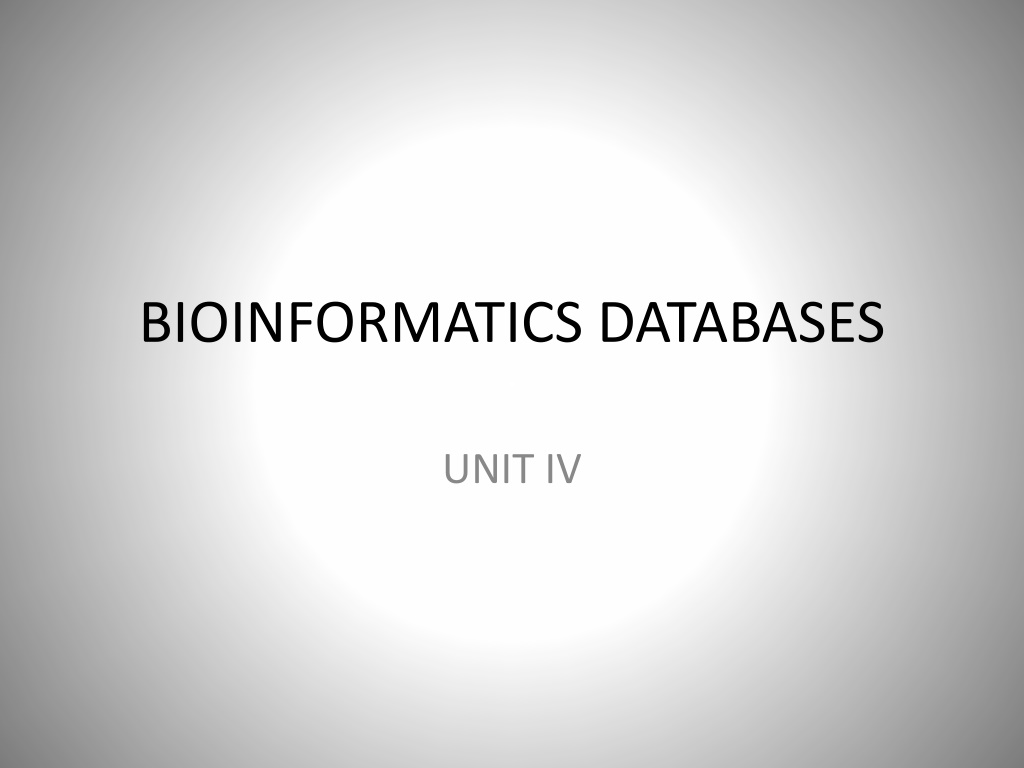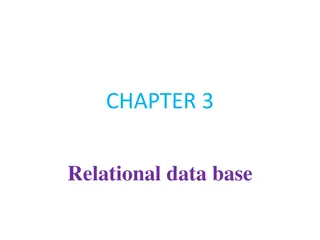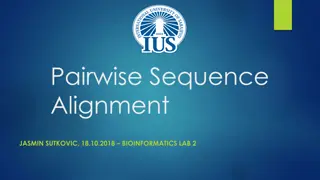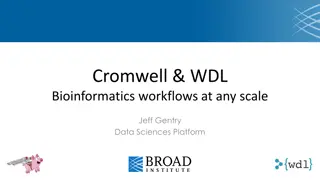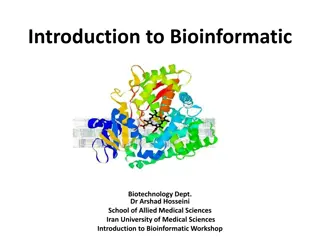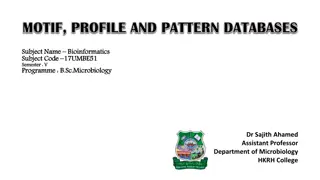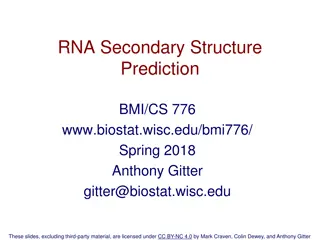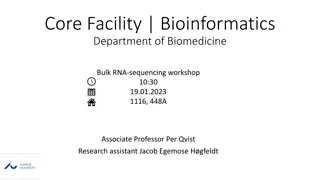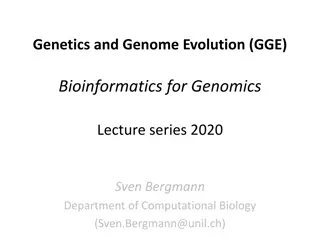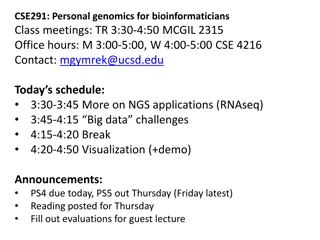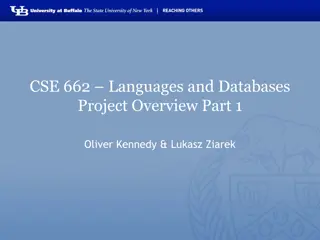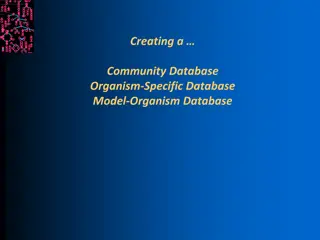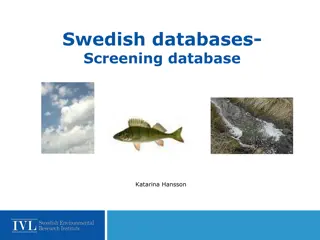Exploring the World of Bioinformatics Databases
Bioinformatics databases are essential tools in handling molecular biological data, classified into sequence and structure databases. Primary databases store raw data, while secondary databases contain curated information for research. Examples include GenBank, Protein Data Bank, and SWISS-Prot.
Download Presentation

Please find below an Image/Link to download the presentation.
The content on the website is provided AS IS for your information and personal use only. It may not be sold, licensed, or shared on other websites without obtaining consent from the author. Download presentation by click this link. If you encounter any issues during the download, it is possible that the publisher has removed the file from their server.
E N D
Presentation Transcript
BIOINFORMATICS DATABASES UNIT IV
DATABASE A database is a computarised library used to store and organize data in such a way that information can be retrieved easily via a variety of search criteria. The development of databases to handle the vast amount of molecular biological data is a fundamental task of bioinformatics. Bioinformatics databases can be broadly classified into sequence and structure databases. Sequence databases are applicable to both nucleic acid sequences and protein sequences,whereas structure databas e is applicable to only proteins.
BIOINFORMATICS DATABASES SEQUENCE DATABASES Applicble to both nucleic acid and protein. STRUCTURE DATABASES Applicable to protein only.
Primary sequence databases In the early 1980 s, several primary database projects evolved in different parts of the world. There are two main classes of databases: DNA (nucleotide) databases and protein databases. The primary sequence databases have grown tremendously over the years. DNA (nucleotide) Databases
Primary database Secondary database These are those that serve the information of particular research interest. Original biological data. Specialized database Manually curated information based on original inf. From primary databases. Eg.Gen bank and Protein Data Bank Eg. SWISS-Prot , Eg. HIV seq. database, European Molecular Biology Laboratory(EMBL) Flybase and ribosomal Database project. DNA Data Bank of Japan (DDBJ) and Protein Information Resources (PIR)
Primary Databases This databases contains the raw sequence or structure data which are produced and submitted by researchers worldwide. GenBank Protein Data Bank( PDB) EMBL ( European Molecular Biology Laboratory) DBJ (DNA Data Bank of Japan) Genbank + EMBL+DDBJ =International Nucleotide sequence Database Collbaration
Secondary Databases In the primary database sequence, annotation information is often miniml.To turn the raw sequence annotation information is needed. This demands for secondary dtabases, It contains computationally processed or manually curated information, based on originally information from primary databases. PIR( Protein information ressource) MIPS (Munich Information Center for Protein SequenceS) SWISS-PROT TrEMBL NRL-3D
Specialized databases These are the databases that serve the information of particular research interest. Eg. HIV sequence database, Flybase and Ribosomal Database project.
Nucleotide sequence databases EMBL, GenBank, and DDBJ are the three primary nucleotide sequence databases EMBL www.ebi.ac.uk/embl/ GenBank www.ncbi.nlm.nih.gov/Genbank/ DDBJ www.ddbj.nig.ac.jp They together constitute the International Nucleotide Sequence database callaboration.
GenBank It is the part of International Nucleotide Sequence Database Collaboration . It is the genetic sequence database, collection of all publicly available DNA sequences. It comprises DNA databases of the DDBJ and EMBL. The Gen Bank Database is present at National Centre for Biotechnology Information. The content includes genomic DNA,mRNA,cDNA.
Genbank GenBank GenBank is a DNA sequence database from National Center Biotechnology Information (NCBI). It incorporates sequences from publicly available sources (direct submission and large-scale sequencing). An annotated collection of all publicly available nucleotide and proteins Set up in 1979 at the LANL (Los Alamos). Maintained since 1992 NCBI (Bethesda). http://www.ncbi.nlm.nih.gov
GEN BANK Presently 18,83,72017 sequences are available in Gen Bank. Gen bank provides flat sequence files which are easy to read. The files contain three sections Header, Features and Sequence entry. Header : this section describes the origin of the sequence, identification of the organism and unique identifiers associated with the record. Features: it includes the detailed information about the gene and gene product, as well as regions of biological significance reported I the sequence. Sequence: This section starts with the label ORIGIN .
The increasing size of database, coupled with the diversity of data sources available have made it convenient to split Genbank into smaller, discrete divisions ( 17to date) Summarised as :
The three letter codes for each of the 17 divisions of Genbank PRI ROD MAM VRT INV PLN BCT RNA VRL PHG SYN UNA EST PAT STS GSS HTG PRIMATE RODENT OTER MAMMALIN OTHER VERTEBRATE INVERTEBRATE PLANT, FUNGAL,ALGAL BACTERIAL STRUCTURALRNA VIRAL BACTERIOPHAGE SYNTHETIC UNANNOTATED EXPRESSION SEQUENCE TAGS PATENT SEQUENCE TAGGED SITES GENOME SURVEY SEQUENCES HIGH THROUGPUT GENOMIC SEQUENCES
EMBL EMBL is a DNA sequence database from European Bioinformatics Institute (EBI). EMBL includes sequences from direct submissions, from genome sequencing projects, scientific literature and patent applications. EMBL supports several retrieval tools: SRS for text based retrieval and Blast and FastA for sequence based retrieval. The European Molecular Biology Laboratory (EMBL) is an international research organisation withits headquarters in Heidelberg(Germany).(1978) EMBL work on the foll. Five principles: Open(free acess) Compatible(easy data sharing) Comprehensive (dealing with all aspects of something) Portable(downloadable and easily instalable) Highquality ( databases are enhanced through annotation, highly qualified biologists add value to databases). All available resources can be accessed via the EBI homepage at http://www.ebi.ac.uk.
EMBL Nucleotide Sequence Database An annotated collection of all publicly available nucleotide and protein sequences Created in 1980 at the European Molecular Biology Laboratory in Heidelberg. Maintained since 1994 by EBI- Cambridge. http://www.ebi.ac.uk/embl.html 7/14/2024 3:14 AM
DDBJDNA Data Bank of Japan An annotated collection of all publicly available nucleotide and protein sequences Started, 1984 at the National Institute of Genetics (NIG) in Mishima. Still maintained in this institute a team led by Takashi Gojobori. http://www.ddbj.nig.ac.jp 7/14/2024 3:14 AM
DDBJ DDBJ (DNA Data Bank of Japan) DNA Data Bank of Japan began DNA data bank activities in earnest in 1986 at the National Institute of Genetics (NIG). DDBJ has been functioning as the international Biological databases and internet resources in bioinformatics L7 3 nucleotide sequence database in collaboration with EBI/EMBL and NCBI/GenBank DDBJ collects sequence data mainly from Japanese researches, but also accepts data and issue the accession numbers to researches in another countries. 99% of INSD(International Nucleotide sequence database) data from Japanese researches are submitted through DDBJ.
Protein Databases (Amino Acid Sequence) PIR - International Protein Sequence Database - The Protein Sequence Database was developed in the early 1960 s. It is located at the National Biomedical Research Foundation (NBRF). Since 1988 it has been maintained by PIR-International. PIR is split into four distinct sections that differ in quality of the data and the level of annotation: PIR1 - fully classified and annotated entries. PIR2 - preliminary entries, not thoroughly reviewed. PIR3 - unverified entries, not reviewed. PIR4 - conceptual translations.
PROTEIN PRIMARY STRUCTURE DATABASE PDB(Protein data Bank) Contains three dimensional structures not only of proteins but also of nucleic acid fragments,RNA molecules and proteins. The database holds data retrived from X-ray crystallography, NMR expts. And molecular modelling. The data in PDB is organized as flat files. Each file contains struct. Of one molecule or molecular complex.
Swiss-Prot Swiss-Prot was established in 1986. It is maintained collaboratively by SIB (Swiss Institute of Bioinformatics) and EBI/EMBL. It contains core data and annotations. Core data consists of the sequences entered in common single letter amino acid code and the related refrences and bibliography. T It also includes the taxanomy of the organism from which the sequence was obtained. Provides high-level annotations, including description of protein function, structure of protein domains, post-translational, modifications, variants, etc. It aims to be minimally redundant. Swiss-Prot is linked to many other resources, including other sequence databases.
TrEMBL TrEMBL - Translated EMBL Translated EMBL was created in 1996 as a computer annotated supplement to Swiss-Prot. It contains translations of all coding sequences in the EMBL nucleotide sequence database. SP-TrEMBL contains entries that will be incorporated into Swiss-Prot REMTrEMBL contains entries that are not destined to be included in Swiss-Prot, (for example, T-cell receptors, patented sequences). The entries in REM-TrEMBL have no accession number.
GenPept GenPept is a supplement to the GenBank nucleotide sequence database. Its entries are translation of coding regions in GenBank entries. They contain minimal annotation, Bioinformatics and Statistical Genomics L7 4 primarily extracted from the corresponding GenBank entries. For the complete annotations, one must refer to the GenBank entry or entries referenced by the accession number(s) in the GenPept entry.
Uniprot United protein databases It is a central repository of protein sequence and function created by joining the information contained in Swiss-prot, Tr EMBL and PIR. It is comprised of three components, each optimised for different uses. 1. Uniprot Knowledgebases ( Uniprot) 2. Uniprot Non reductant refrence ( Uniref) Uniprot Archeive ( Uniparc)
NRL 3D NRL 3D is produced and maintained by PIR. It contains sequences extracted from the Protein DataBank (PDB). The entries include secondary structure, active site, binding site and modified site annotations, details of experimental method, resolution, Rfactor, etc. NRL 3D makes the sequence data in the PDB available for both text based and sequencebased searching. It also provides cross-reference information for use with the other PIR Protein Sequence Databases.
CSD Cambridge Structural Database Originally a project of the University of cambridge. It was set up to collect togather the published three dimensional strucure of small organic molecules. Currently it holds crystal information for about 2.5 lakhs organic and metal organic compounds, Small peptides such as neuropeptides,moner and dimer of nucleic acids.
Secondary structure database NDB ( Nucleic acid database) It is the database of 3D structures containing nucleic acid( A, B, and Z polymorphic forms) and all classes of RNA in the form of an ATLAS which can be browsed and searched to obtain the structure required. Each entry in the ATLAS has information on sequence, crystallization condition, refrences andother details. The database also stores average parameters for nucleic acids, obtained by statistical analysis of the structures. These parameters are widely used in computersimulations of nucleic acids and their interactions.
SCOP Structural Classification of Proteins It is a searchable and browsable database. Each entry also has other annotation regarding function etc, and other links to other databases including other structural classification such as CATH.
CATH Class, architecture, Topology and Homologous Super family. The structures chosen for classification are a subset of PDB, consisting of those that have been determined to a high degree of accuracy.
